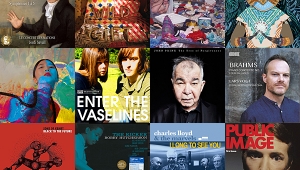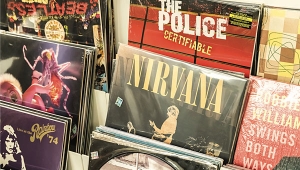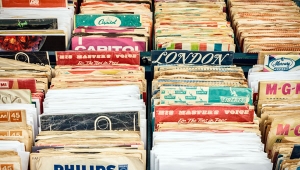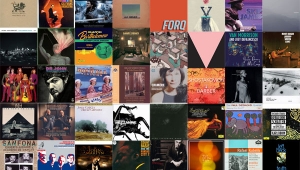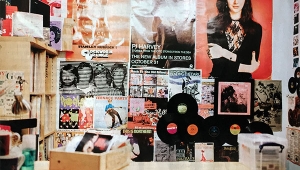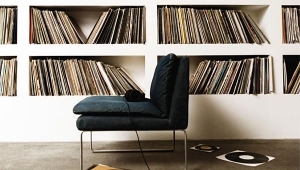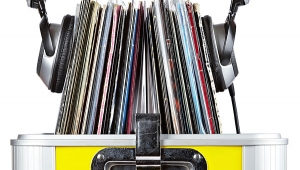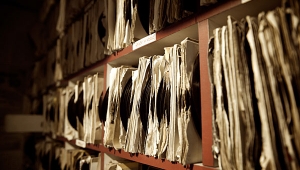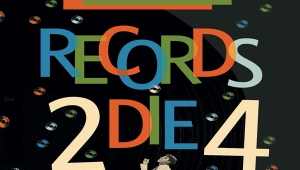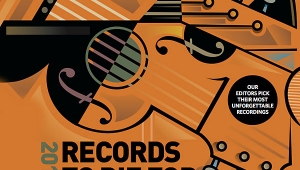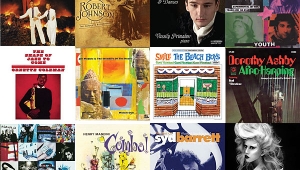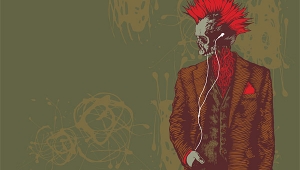| Columns Retired Columns & Blogs |
1992 Records To Die For Page 4
Markus Sauer
When I got Richard Lehnert's fax telling me I was invited to contribute to this year's edition of Stereophile's "Recommended Recordings" feature, the first thing I did was to dig out the first installment in the January 1991 issue. I wanted to see what my fellow contributors recommended last year in order to avoid duplicating their choices.
THE SONNY CLARK MEMORIAL QUARTET: Voodoo
Wayne Horvitz, piano; John Zorn, alto sax; Ray Drummond, bass; Bobby Previte, drums
Black Saint BSR 0109 (LP; CD available). Jon Rosenberg, eng. TT: 43:01
The description "modern hard bop" usually drives me away from an album, because I associate it with drivel like most of Wynton Marsalis's output. And the idea of Wayne Horvitz and John Zorn paying tribute to an all but obscure pianist is not one of the greatest sales concepts of all times. (Although I thoroughly recommend John Zorn's Spillane and Naked City to the more adventurous listener.) And several tracks on this album repeat some of the less palatable hard-bop clichés. But the first two tracks on side two---the title track at close on 11 minutes, and "Sonia"---lift this record out of the morasses of the hard-bop revival: they are breathtakingly good and do what all jazz music should do: they talk to your soul.
BEN WEBSTER: At the Renaissance
Ben Webster, tenor sax; Jimmy Rowles, piano; Jim Hall, guitar; Red Mitchell, bass; Frank Butler, drums
Fantasy OJC-390 (LP), OJCCD-390-2 (CD). Howard Holzer, eng. AAA/AAD.
"Why can't I get to play with guys like that any more?" Ben Webster is quoted in the liner notes. And why can't we all go to a club anymore and get to hear such great, warm, human music? This record, recorded in 1960, is a clear indication of the decline of Western civilization.
JONATHAN RICHMAN & THE MODERN LOVERS: Rock 'n Roll with the Modern Lovers
Beserkley/Rhino RNLP 70093 (LP). Matthew King Kaufman, Glen Kolotkin, prods. AAA.
If I remember the Survey correctly, most of you Stereophile readers are in an age bracket where being plagued by teenage children is a distinct possibility. Okay; ask your children if they know of a band practicing in your neighborhood. Get an emergency supply of earplugs, find the place, and sit down quietly in a corner.
LED ZEPPELIN: Led Zeppelin
Atlantic SD 19126 (LP), -2 (CD). Jimmy Page, prod.; Glyn Johns, eng. AAA/AAD. TT: 41:45
Some music simply takes command of your body and won't let go 'til you've paid with your soul. For me, it's neither the Beatles nor the Rolling Stones---I fell victim to the band that later epitomized rock's darkest debauchery, Led Zeppelin. I'm a sucker for Robert Plant's voice (I even play his solo albums), and the combination of passion, grace, and power in Jimmy Page's guitar playing remains unsurpassed. It's no wonder that John Bonham's forceful drums have been widely sampled, and John Paul Jones's bass provides the perfect base for the group's sound---heavy blues-rock's finest hours.
HÉROLD: La Fille Mal Gardée (excerpts)
John Lanchbery, Orchestra of the Royal Opera House, Covent Garden
Decca SXL 2313 (LP, op). AAA.
Ballet music, of which this is an example, often suffers from the same problems as film music: without the action for which the music was intended, it doesn't make much sense. Happily, La Fille Mal Gardée's score stands up well without two dozen peasant girls flashing well-formed thighs at you. It serves nicely as elegant and joyous, if somewhat lightweight, entertainment.
Michael Ross
PAUL DESMOND QUARTET & JIM HALL: The Complete Recordings
Mosaic MR6-120 (6 LPs), MD4-120 (4 CDs). Ray Hall, Bob Simpson, engs.; George Avakian, Bob Prince, original session prods.; Michael Cuscuna, reissue prod. AAA/AAD. TT: 4:38:19
Available only by mail from Mosaic, 35 Melrose Place, Stamford, CT 06902. Tel: (203) 327-7111
To paraphrase Oscar Wilde, "I don't require much from music; the best is always good enough for me." All I require is soul, wit, intelligence, individuality, texture, taste, tension, release, and good tone. In jazz, add a sense of spontaneous composition and adventure, and I'm happy. The Mosaic sessions of Paul Desmond and Jim Hall make me very happy indeed.
JOHN HAMMOND: I Can Tell
Atlantic SD8152 (LP). Mike Stoller, Jerry Leiber, prods. AAA.
From 1964 to 1966, the legendary songwriting team of Leiber and Stoller had their own record label named Red Bird. Among the label's artists was a blues singer named John Hammond who had achieved some notoriety in folk circles while on Vanguard. By 1967 Red Bird was history and Hammond's only LP was released on Atlantic.
Dick Olsher
ANTILL: Corroboree (a symphonic ballet)
John Lanchbery, Sydney Symphony Orchestra
EMI (Australia) OASD.7603 (LP). Barry Smith, eng.; Eric Clapham, prod. AAA. TT: 46:02
John Antill's Corroboree sets out to capture the mood and primal intensity of an Australian Aboriginal dance ceremony. As a small boy Antill had witnessed the wonders of such a dance spectacle on the northern tip of Botany Bay. The memories of that night coalesced much later into a full symphonic ballet.
STRAUSS: Also Sprach Zarathustra
Fritz Reiner, Chicago SO
RCA LSC-2609 (LP). Lewis Layton, eng.; Richard Mohr, prod. AAA.
Never mind the "Dawn" prologue which has become wedded to Kubrick's epic film 2001. There's a lot more to Richard Struass's Nietzschean tribute than the opening fanfare. There's hardly a more tonally lush and texturally complex score out there. And for my money, I'd rather have Fritz Reiner on the podium. I can just imagine little Fritz exhorting the orchestra: "Play with inspiration, not perspiration." Give the man his due. He's a master at fleshing out the incandescence of a Strauss score. He worked with Strauss for a number of years at the Dresden Opera and conducted the Dresden premiere of Die Frau ohne Schatten.
When I got Richard Lehnert's fax telling me I was invited to contribute to this year's edition of Stereophile's "Recommended Recordings" feature, the first thing I did was to dig out the first installment in the January 1991 issue. I wanted to see what my fellow contributors recommended last year in order to avoid duplicating their choices.
Damn. Miles Davis's Kind of Blue and Weather Report's Heavy Weather were mentioned, as were Andreas Vollenweider's Caverna Magica, Jimi Hendrix's Electric Ladyland, Italian Violin Music on Edition Open Window, Respighi's Pines and Fountains of Rome on Chesky, Ramirez's Misa Criolla with Carreras on Philips, Derek and the Dominoes' Layla, Grace Jones's Nightclubbing, even Sly and the Family Stone's There's a Riot Going On---it's unfair! How can I compile my own list when so many great records from my own collection have already been "taken" by others? And how can this magazine choose a format for its record recommendations that doesn't allow me to put Prince's Purple Rain on my list? If musical excellence were to be allowed to compensate for mediocre sonics, that album would be placed near the top of my recommendations. Oh well, maybe I can sneak in a Led Zep album...
THE SONNY CLARK MEMORIAL QUARTET: Voodoo
Wayne Horvitz, piano; John Zorn, alto sax; Ray Drummond, bass; Bobby Previte, drums
Black Saint BSR 0109 (LP; CD available). Jon Rosenberg, eng. TT: 43:01
The description "modern hard bop" usually drives me away from an album, because I associate it with drivel like most of Wynton Marsalis's output. And the idea of Wayne Horvitz and John Zorn paying tribute to an all but obscure pianist is not one of the greatest sales concepts of all times. (Although I thoroughly recommend John Zorn's Spillane and Naked City to the more adventurous listener.) And several tracks on this album repeat some of the less palatable hard-bop clichés. But the first two tracks on side two---the title track at close on 11 minutes, and "Sonia"---lift this record out of the morasses of the hard-bop revival: they are breathtakingly good and do what all jazz music should do: they talk to your soul.
One of my dealer friends hates this record because it makes almost any system sound good. He's right; the almost supernatural (palpable?) presence of this studio recording leads me to suspect some Aphex trickery, but the effect is certainly convincing.
BEN WEBSTER: At the Renaissance
Ben Webster, tenor sax; Jimmy Rowles, piano; Jim Hall, guitar; Red Mitchell, bass; Frank Butler, drums
Fantasy OJC-390 (LP), OJCCD-390-2 (CD). Howard Holzer, eng. AAA/AAD.
"Why can't I get to play with guys like that any more?" Ben Webster is quoted in the liner notes. And why can't we all go to a club anymore and get to hear such great, warm, human music? This record, recorded in 1960, is a clear indication of the decline of Western civilization.
Ben Webster's saxophone had the most sensuous tone ever. Here he is captured live and in excellent form with musicians for whom the title "sidemen" just isn't appropriate, in a relaxed, intimate club setting. This is also the kind of record that should be played at hi-fi shows, instead of the tedious Jazz at the Pawnshop. Wonderful.
JONATHAN RICHMAN & THE MODERN LOVERS: Rock 'n Roll with the Modern Lovers
Beserkley/Rhino RNLP 70093 (LP). Matthew King Kaufman, Glen Kolotkin, prods. AAA.
If I remember the Survey correctly, most of you Stereophile readers are in an age bracket where being plagued by teenage children is a distinct possibility. Okay; ask your children if they know of a band practicing in your neighborhood. Get an emergency supply of earplugs, find the place, and sit down quietly in a corner.
If all you can find are Guns'n'Roses clones, listen to this record. It captures the sound of a young band in some obscure garage (actually, a CBS studio in San Francisco) like no other recording I know of. The music may not be perfect, but it's played with youthful exuberance: post-hippie folk rock with a huge sense of humor, including the original version of "Egyptian Reggae," without the artificiality that later marred much of Richman's work. This is fun!
LED ZEPPELIN: Led Zeppelin
Atlantic SD 19126 (LP), -2 (CD). Jimmy Page, prod.; Glyn Johns, eng. AAA/AAD. TT: 41:45
Some music simply takes command of your body and won't let go 'til you've paid with your soul. For me, it's neither the Beatles nor the Rolling Stones---I fell victim to the band that later epitomized rock's darkest debauchery, Led Zeppelin. I'm a sucker for Robert Plant's voice (I even play his solo albums), and the combination of passion, grace, and power in Jimmy Page's guitar playing remains unsurpassed. It's no wonder that John Bonham's forceful drums have been widely sampled, and John Paul Jones's bass provides the perfect base for the group's sound---heavy blues-rock's finest hours.
The sound may be only so-so in absolute terms---no crystal-clear delicate vocals here!---but it is a faithful rendition of a good PA system and continues to improve with hardware advances (especially in my front end). Perfectly illustrating the power and majesty of real rock before it degenerated to heavy metal, this record alone is justification enough for 15" woofers in huge cabinets.
HÉROLD: La Fille Mal Gardée (excerpts)
John Lanchbery, Orchestra of the Royal Opera House, Covent Garden
Decca SXL 2313 (LP, op). AAA.
Ballet music, of which this is an example, often suffers from the same problems as film music: without the action for which the music was intended, it doesn't make much sense. Happily, La Fille Mal Gardée's score stands up well without two dozen peasant girls flashing well-formed thighs at you. It serves nicely as elegant and joyous, if somewhat lightweight, entertainment.
The sonics of this 1962 recording are spectacularly good, even on my modern Dutch pressing (originals are reputed to be better still): excellent orchestral tone, superb shading of dynamics, especially at the soft end of the spectrum, and completely natural perspectives---would someone please force the record companies to use tube mikes again?
Michael Ross
PAUL DESMOND QUARTET & JIM HALL: The Complete Recordings
Mosaic MR6-120 (6 LPs), MD4-120 (4 CDs). Ray Hall, Bob Simpson, engs.; George Avakian, Bob Prince, original session prods.; Michael Cuscuna, reissue prod. AAA/AAD. TT: 4:38:19
Available only by mail from Mosaic, 35 Melrose Place, Stamford, CT 06902. Tel: (203) 327-7111
To paraphrase Oscar Wilde, "I don't require much from music; the best is always good enough for me." All I require is soul, wit, intelligence, individuality, texture, taste, tension, release, and good tone. In jazz, add a sense of spontaneous composition and adventure, and I'm happy. The Mosaic sessions of Paul Desmond and Jim Hall make me very happy indeed.
Mosaic still releases all of their recordings on CD and vinyl. The sound of both in this set is extremely musical and probably as close as the media will allow. Personally, I prefer the sound of brushes on a snare on the vinyl, and there's lots of brushwork here.
Listening to Desmond and Hall on these sessions is like being at the Algonquin round table, as the two friends toss musical bon mots back and forth. The best is good enough for me; musically and sonically, this is as good as it gets.
JOHN HAMMOND: I Can Tell
Atlantic SD8152 (LP). Mike Stoller, Jerry Leiber, prods. AAA.
From 1964 to 1966, the legendary songwriting team of Leiber and Stoller had their own record label named Red Bird. Among the label's artists was a blues singer named John Hammond who had achieved some notoriety in folk circles while on Vanguard. By 1967 Red Bird was history and Hammond's only LP was released on Atlantic.
I Can Tell features a core group of Hammond on guitar and harmonica, New Orleans drummer Charles Otis, and Rick Danko and Robbie Robertson (not quite yet of the Band) on bass and guitar.
Hammond performs classics by Muddy Waters, Howling Wolf, Jimmy Reed, and Chuck Berry in a style that is at once absolutely true to the spirit of the originals and wholly his own.
Leiber and Stoller have achieved the near-impossible in capturing all the excitement of ferocious live performances while adding production touches that make the sound of the record as timeless as the music.
The LP is long out of print; find it if you can. It represents a rare occasion when the rawness of the blues met the gloss of pop and both emerged the better for it.
Dick Olsher
ANTILL: Corroboree (a symphonic ballet)
John Lanchbery, Sydney Symphony Orchestra
EMI (Australia) OASD.7603 (LP). Barry Smith, eng.; Eric Clapham, prod. AAA. TT: 46:02
John Antill's Corroboree sets out to capture the mood and primal intensity of an Australian Aboriginal dance ceremony. As a small boy Antill had witnessed the wonders of such a dance spectacle on the northern tip of Botany Bay. The memories of that night coalesced much later into a full symphonic ballet.
If you're ready for something different, a musical change of pace, throw this one on your turntable. Dim, or better yet, turn off the lights in your listening room, and inch up the volume control a couple of notches. I guarantee that the rhythms and colors of the Aborigine will transport you from the comforts of your chair to the midst of brightly painted tribal dancers far away under a starry sky.
The music is heavily dependent on percussive effects for the maintenance of the dance rhythms. The scoring for the percussion is nothing short of amazing: xylophone, vibraphone, bass drum, thora sticks (two hardwood sticks struck together), two cymbals, two gongs, triangle, tambourine, snare drum, slap stick, ratchet, tom tom, woodblock, sleighbells, castanets, sand blocks, Chinese temple blocks, thunder sheet, bull roarer (a cigar-shaped wooden flat attached to a cord at one end and twirled about the head rapidly), a partridge, and a pear tree.
All of the percussion is easy to resolve within an exceptionally vibrant soundstage. The dynamics during the closing "Fire Ceremony" are crushing in their intensity. Warning: beware of the bull roarer during the the climax (the timid are advised to duck their heads). The pressing features fantastically quiet surfaces. Next time you need a vacation to an exotic locale, don't call your travel agent---dial in Corroboree. This recording has got it all.
STRAUSS: Also Sprach Zarathustra
Fritz Reiner, Chicago SO
RCA LSC-2609 (LP). Lewis Layton, eng.; Richard Mohr, prod. AAA.
Never mind the "Dawn" prologue which has become wedded to Kubrick's epic film 2001. There's a lot more to Richard Struass's Nietzschean tribute than the opening fanfare. There's hardly a more tonally lush and texturally complex score out there. And for my money, I'd rather have Fritz Reiner on the podium. I can just imagine little Fritz exhorting the orchestra: "Play with inspiration, not perspiration." Give the man his due. He's a master at fleshing out the incandescence of a Strauss score. He worked with Strauss for a number of years at the Dresden Opera and conducted the Dresden premiere of Die Frau ohne Schatten.
Some may argue in favor of Reiner's 1954 recording (also with RCA) as being even more radiant. But it is this recording's combination of dramatic intensity and textural resolution that makes it the supreme Zarathustra to own and enjoy again and again. Kudos to Mohr and Layton for precisely capturing the perspective of Orchestra Hall. When I put this record on, I'm transfixed all the way through to the final chord. (XI-11)
- Log in or register to post comments

